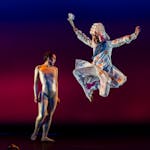Laura Wertheim Joseph is a jack of all trades when it comes to selecting and interpreting art. She discovered her love of art accidentally, when she was an international studies and Francophone major at Macalester College and realized that she only wanted to take a visual approach to big questions.
She's held the unusual position of curatorial adviser for the private art collection of former Minnesota Supreme Court Justice and Vikings defensive tackle Alan Page and his late wife, Diane Sims Page, and was a consulting curator for the Weisman Art Museum.
Now, she's taking on a new job as curator for the newly renovated and relocated Minnesota Museum of American Art (the M) in St. Paul. This will be her first staff curator job.
"She's a curator who understands that the past is always moving," said Robyne Robinson, the M's new board chairwoman.
Joseph's appointment comes at a key moment for the M, which is beginning the second phase of its two-part, $23 million renovation and expansion. It's expected to be completed late next year with new space for the museum's permanent collection. She will be in charge of figuring out how to best showcase the M's pieces in the new addition.
Joseph has organized shows about Minnesota's feminist art history and Americana from slavery to the present. Now she is eager to tackle pivotal historical moments, and to bring forth lesser-known artists.
The Star Tribune caught up with Joseph by phone. This interview has been edited for clarity.
Q: What drew you to become a staff curator at the M?
A: I have been really excited about the M and its future since the George Morrison show. [Morrison is an Ojibwe modernist artist whose show "Modern Spirit: The Art of George Morrison" toured from 2013-2015.] For me that show set a really important tone for the museum — it showcased the museum's leadership in recognizing Morrison's innovative and indigenous approach to modernism. It was the first and only survey of the artist to date, and was made possible by the fact that the museum holds the largest collection of the artist's work.
I have watched as the M has continued to build on this foundation in important and thoughtful ways — the Ken Gonzales-Day "Shadowlands" exhibition in 2017, and the current Brad Kahlhamer "A Nation of One" exhibition are two examples.
Q: How did working with Interact Center for the Visual and Performing Arts, a St. Paul-based arts center for adults with disabilities, inform your curatorial approach?
A: Because of my recent experience at Interact, something that's been on my mind lately is the way that artists with disabilities face systemic and attitudinal barriers. I was excited when I applied that the M had this show up by Dietrich Sieling [who is autistic].
I think there are widespread calls to decolonize museums, and to call into question their place of privilege. That's happening all around the world, and the M needs to be a part of those conversations and seriously consider the role it will play to move these conversations forward and advance this work.
Q: You're most interested in organizing shows with themes that you refer to as "under-researched." What do you mean?
A: Things that are at the margins, or topics; it's often been artists at the margins. My dissertation was called "Shadow Feminism," so it was really looking at, you know, what is the story that we tend to do about art, what is in the shadows of that? I am always drawing on undervalued sources of knowledge and wisdom. I am very interested in textiles, in materials that have been feminized or dismissed as a result of their association with the feminine. I am also very interested in questions of the environment.
Q: What are some of the shows you're already thinking about to kick things off at the M?
A: I think my first job is going to be working on the permanent collection, and how do we display that for the fall 2020 opening of this new space. I anticipate working with a lot of contemporary artists to engage the collection — artists who are particularly interested in how objects have multiple lives and are interested in looking at historic objects and engaging with them in a way that might reveal something that we maybe wouldn't see.





